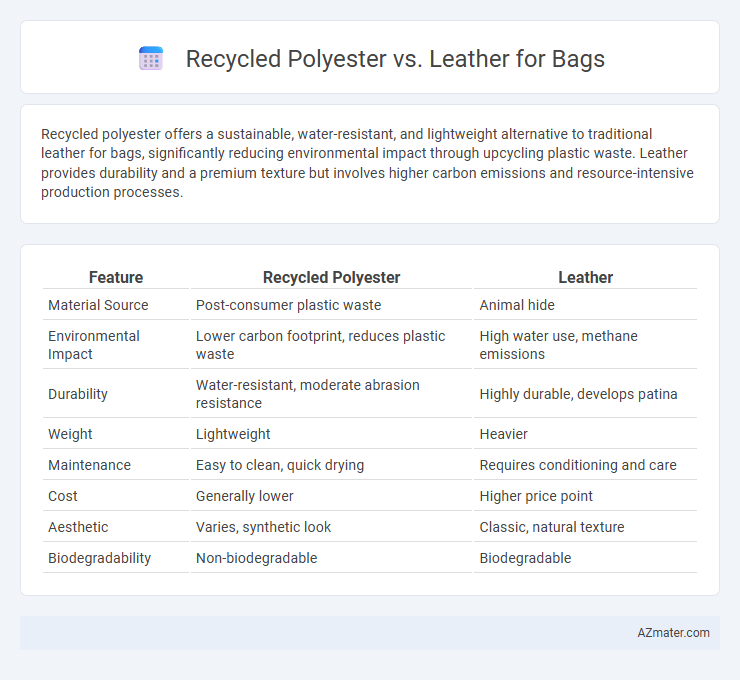Recycled polyester offers a sustainable, water-resistant, and lightweight alternative to traditional leather for bags, significantly reducing environmental impact through upcycling plastic waste. Leather provides durability and a premium texture but involves higher carbon emissions and resource-intensive production processes.
Table of Comparison
| Feature | Recycled Polyester | Leather |
|---|---|---|
| Material Source | Post-consumer plastic waste | Animal hide |
| Environmental Impact | Lower carbon footprint, reduces plastic waste | High water use, methane emissions |
| Durability | Water-resistant, moderate abrasion resistance | Highly durable, develops patina |
| Weight | Lightweight | Heavier |
| Maintenance | Easy to clean, quick drying | Requires conditioning and care |
| Cost | Generally lower | Higher price point |
| Aesthetic | Varies, synthetic look | Classic, natural texture |
| Biodegradability | Non-biodegradable | Biodegradable |
Introduction: The Shift Towards Sustainable Bag Materials
Recycled polyester and leather represent two distinct approaches in sustainable bag materials, with recycled polyester offering eco-friendly benefits through the reuse of plastic waste, reducing landfill impact and lowering carbon emissions. Leather, traditionally valued for its durability and luxury appeal, faces environmental scrutiny due to resource-intensive tanning processes and ethical concerns around animal use. The growing consumer demand for environmentally responsible products drives innovation in both materials, prompting manufacturers to balance sustainability with performance and aesthetics.
What is Recycled Polyester?
Recycled polyester is a sustainable fabric made from post-consumer plastic waste such as PET bottles, which are melted and spun into new fibers, reducing landfill and ocean pollution. This eco-friendly material offers durability, water resistance, and lightweight properties, making it an ideal alternative to traditional leather in bag manufacturing. Unlike leather, recycled polyester requires less water and energy to produce, significantly lowering the environmental footprint of bags.
Understanding Leather: Types and Sources
Leather used in bags varies primarily between full-grain, top-grain, genuine, and bonded types, each differing in durability and texture. Sources of leather include cowhide, sheepskin, and exotic skins, with cowhide being the most common for its strength and aging qualities. Understanding these types and sources helps buyers make informed decisions about the quality, sustainability, and price of leather products compared to recycled polyester alternatives.
Environmental Impact: Recycled Polyester vs Leather
Recycled polyester bags significantly reduce environmental impact by repurposing plastic waste and lowering greenhouse gas emissions compared to traditional leather production, which involves high water consumption, deforestation, and methane release from livestock. Leather manufacturing also employs toxic chemicals during tanning processes that contaminate water sources and soil. Selecting recycled polyester over leather supports sustainability through resource conservation and pollution reduction.
Durability and Longevity: Which Material Lasts Longer?
Recycled polyester offers high resistance to water, stains, and scratches, maintaining its durability even after extended use, making it ideal for everyday bags exposed to various elements. Genuine leather, especially full-grain leather, develops a natural patina over time, enhancing its strength and longevity, often lasting decades with proper care. Compared to leather, recycled polyester resists abrasion and environmental damage better but may lack the same long-term robustness and aging qualities that contribute to leather's enduring lifespan.
Aesthetic Differences: Appearance and Style Choices
Recycled polyester bags offer a sleek, modern look with vibrant colors and varied textures, making them ideal for contemporary and casual styles. Leather bags provide a classic, timeless appeal with natural grain patterns and patina that develop over time, enhancing their sophistication and luxury. The choice between recycled polyester and leather hinges on preference for eco-friendly versatility versus enduring elegance and rich texture.
Comfort and Weight: Everyday Use Considerations
Recycled polyester bags offer lightweight properties and enhanced breathability, making them comfortable for extended everyday use compared to leather. Leather bags provide a sturdier structure but tend to be heavier and less flexible, potentially causing discomfort during prolonged carrying. Comfort and weight preferences depend on daily activity levels, with recycled polyester favoring casual, active lifestyles and leather better suited for more formal or short-duration use.
Maintenance and Cleaning Requirements
Recycled polyester bags require minimal maintenance, as they are water-resistant and can be spot-cleaned with mild soap and water, making them ideal for everyday use. Leather bags need more intensive care, including regular conditioning to prevent drying and cracking, as well as professional cleaning for stains and deep dirt. Choosing recycled polyester reduces upkeep time and costs, while leather offers durability but demands consistent, specialized maintenance.
Cost Comparison: Affordability and Value
Recycled polyester bags typically offer greater affordability, with prices often 30-50% lower than genuine leather options, making them a budget-friendly choice for eco-conscious consumers. Leather bags provide long-term value due to their durability and timeless style, despite higher initial costs ranging from $100 to over $500. Evaluating cost-effectiveness depends on whether upfront savings with recycled polyester or the extended lifespan and premium appeal of leather aligns better with personal priorities.
Ethical Factors: Animal Welfare and Eco-Friendly Choices
Recycled polyester bags contribute to animal welfare by eliminating the need for animal-derived materials, reducing harm to livestock and wildlife compared to leather bags that require animal hides. Environmentally, recycled polyester minimizes landfill waste and lowers carbon emissions by repurposing plastic, whereas leather production involves resource-intensive processes with significant water use and greenhouse gas emissions. Choosing recycled polyester aligns with ethical consumption by supporting cruelty-free manufacturing and promoting eco-friendly practices that mitigate environmental degradation.

Infographic: Recycled polyester vs Leather for Bag
 azmater.com
azmater.com